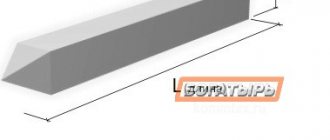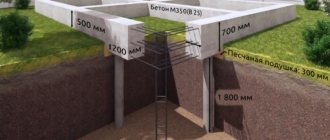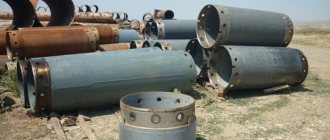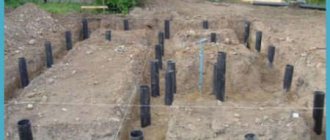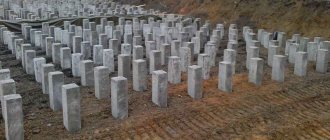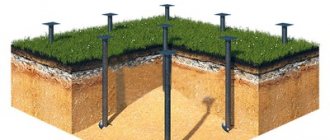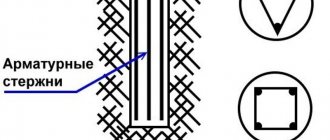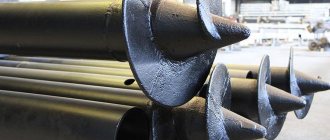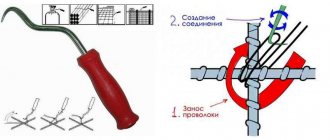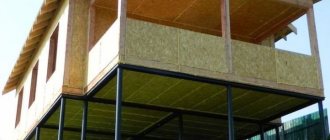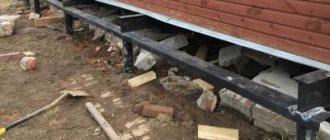Reinforcement of a columnar foundation is a prerequisite for obtaining a strong, reliable foundation for a house. Concrete can withstand compressive loads, but deforms when subjected to bending and tension. There are several types of metal frames for bored piles. They are mounted using different technologies depending on the parameters of the support and its operating conditions.
Types of metal frame
Reinforcement can be of several types:
- Flat, made of several layers of metal rods connected to each other by transverse bridges using wire or welding. They are used as a basis for laying bored supports and increasing the strength of reinforced concrete supports of small diameter.
- Volumetric in the form of a circle or square, manufactured using automated welding lines. Requires accurate calculations before installation. They are used for structures that bear a significant load from house construction.
According to GOST 10992, reinforcement of piles can be longitudinal and transverse-longitudinal.
The longitudinal method is used to reinforce structures installed in stable soil of medium density: sandy loam, clay, loam. In seismically active areas, such reinforcement is not used due to poor resistance to bending and tension.
The reinforced longitudinal frame consists of corrugated metal rods connected to each other using jumpers. The longitudinal row should have from 4 to 8 rows of rods, with a cross-section from 12 to 15 mm.
During the driving process, the upper and lower parts of the pile experience maximum load. To prevent the structure from deforming, it is reinforced on top with steel mesh installed at a distance of 50 mm from each other. 4-5 pieces of such grids are installed. The lower part is reinforced with a steel cage made in the shape of a cone. It is welded to protruding reinforcement bars bent inward.
Round frame.
The longitudinal-transverse method is more reliable. Due to the high consumption of metal, such supports are much more expensive. But they are able to withstand increased loads. The frame is made from metal rods with a diameter of 11 to 15 mm, class A1 or A2. The transverse jumpers connecting the longitudinal rows are made of metal, with a cross-section from 8 to 12 mm.
When reinforcing round supports, steel mesh assembled into a cylinder is sometimes used.
The distance between the crossbars is selected depending on the density of the soil. In the central part the pitch is 200-300 mm. If the support is more than 12 m, the distance between the jumpers should be no more than 200 mm.
The upper ends of the supports are reinforced with a mesh of reinforcement, and a steel tip is placed on the lower end.
The advantage of reinforced frames
The main tasks of reinforcement cages are to be able to strengthen any types of reinforced concrete structures for a long time and with a high level of reliability. This applies, among other things, to bored piles with a 30-centimeter diameter. Screw piles operate on different principles.
At the initial stages of pouring work, which is directly related to the creation of a monolithic foundation base in fiberglass pipes or during the installation of a bored support, which has a diameter of 0.3 m, reinforced frames of such types are used that can be formed in total into 3-4 conventional frames and grillages.
We also note that the production processes of a reinforced pile (as opposed to a screw pile), in accordance with SNiPs, can take place using frames of square and round type (we are talking exclusively about the shape of the section). Let us remind you that most often reinforcement frames for bored supports have dimensions of 0.3 m.
BNS frames are used quite widely in the process of building a foundation, which must have a sufficient burial depth. The support, unlike a screw-type pile, must be cylindrical in shape, consist of a fiberglass shell and contain reinforced circles with a diameter of 0.3 m.
SNiP requires that reinforced frames for foundations (we are talking about longitudinal reinforced frames) consist of reinforcement with a diameter of about 0.5 m. Reinforced frames for bored-type supports have such wide applications due to a long list of obvious advantages:
- Production cycles can be significantly reduced;
- The rate of installation of reinforced concrete structures can be significantly increased;
- It is possible to use waste from reinforcement having a cross-section of 0.4 m;
- Can be used on any surface;
- The profitability of construction work is significantly higher;
Calculation of frame parameters
Pile foundations are widely used in the construction of small houses made of lightweight materials. The higher the mass of the building, the wider the cross-section of the support should be. The most commonly used are bored piles with a diameter of 30 cm.
When calculating the number of supports, their cross-section and method of reinforcement, it is necessary to take into account the characteristics of the soil on the construction site and the weight of the house, taking into account the materials used for construction, furniture, and people who may be in the house.
It is better to entrust such an important stage to professionals. If the calculations are incorrect, the support may not withstand the load-bearing load from housing construction and may become deformed or collapse. This will entail, at best, the need for major repairs, and in the worst case scenario, it will pose a threat to the lives of people in the house.
On stable soils, when a layer of dense soil is reached, piles with a cross-section of 30 cm and a length of 2.5 mm will be sufficient. To install a foundation for medium-sized housing construction, you will need about 40 pieces of reinforced piles.
Advantages
Reinforcement structures have many advantages that not only strengthen the future structure, but also simplify construction. The main advantages of the reinforcement cage are as follows:
- a foundation reinforced with reinforcement can be built on any soil;
- the cycle of construction work is significantly reduced - fewer workers are required;
- production profitability increases;
- increasing the speed of installation of reinforced concrete structures.
Reinforcement of bored piles
Bored supports are manufactured at the construction site, and they are also reinforced with a metal frame there.
A well of the required size is drilled in the ground. The pre-assembled steel frame is then inserted into it using a crane. Then the pipe is installed and filled with concrete.
Sequence of installation of bored piles:
- Perform all necessary calculations. The number and diameter of piles are determined.
- According to the project, the location of supports on the site is marked.
- They drill a well: 150-200 cm of earth is removed using a drill bit, the remaining depth is reached using an auger.
- Sand, 250-300 mm thick, is poured into the bottom of the hole; the sand cushion serves to increase the load-bearing properties of the soil.
- The casing pipe, which serves as formwork, is lowered.
- Reinforcement of bored piles is carried out. A frame made of reinforcement is inserted into the drilled hole using a crane. It is made with horizontal strapping from vertical rods with a diameter of 10-16 mm.
- The well is filled with cement-sand mortar prepared in a ratio of 1:3.
- The casing pipe is raised as the cavity is filled with solution.
- When the well is completely filled with concrete solution, the casing pipe is removed and the head of the support is formed.
To prevent damage to the integrity of the newly poured pile, the supports are poured with concrete solution one at a time. The adjacent pile is mounted after the previous one has gained strength of at least 30%.
General information about bored piles
Bored and drilled secant piles can consist only of concrete, but new reinforced concrete structures have higher performance characteristics due to the use of reinforcement. Despite the apparent complexity of this technology, absolutely all stages of their production can be performed by untrained persons without special education. Remember that reinforcement of bored piles is a relatively simple technology that will significantly strengthen the foundation of your house.
To carry out work on creating such a foundation, you will need some specific tools:
- Automatic drill - depending on the depth to which the pile needs to be driven, the drill is selected according to the power and length of the drilling arm. Of course, if the depth is shallow, then ordinary hand-held garden augers can be used, but much more efficiently and quickly the work will be carried out with an autonomous gas ax or drilling rig;
- One or more concrete mixers, shovels, trowels and buckets;
- Grinder with a minimum set of discs for working with reinforcement;
Among other things, before starting work it is necessary to check the stock of necessary materials, among which the presence of:
- Casing pipes or roofing felt;
- Fittings for strengthening or reinforcing bored piles;
- The required amount of cement, sand, crushed stone - to create a concrete solution of proper quality;
Remember that by providing yourself with everything you need in advance, you will minimize temporary losses in the future.
Reinforcement of drill-injection supports
The technology for installing drilled injection piles is similar to installing bored supports. Only the sequence when pouring and installing reinforcement changes.
When installing drill-injection supports, first the hole is filled with cement mortar, and immediately before it hardens, a pre-mounted reinforced frame is lowered inside.
Drill injection construction involves the method of injecting fine concrete into a pre-prepared well. In this way, supports with a cross section of up to 25 cm are installed.
Bored foundation: calculation, design and others
We work in Moscow and other regions of the Russian Federation. We offer installation of bored piles of any type:
- pile foundations;
- secant and drilled tangential piles for any purpose - foundations, fences, walls in the ground;
- drilling injection for repairing and strengthening foundations and retaining walls;
- TISE foundations;
- grillages.
Completed projects that we are proud of
Moscow, bridge support
Photo report on the installation of piles by specialists of PSK Osnovaniye i Foundations LLC
More details
Tver, Pig breeding complex
Installation of drilled injection piles during the construction of a pig-breeding complex
More details
Zhukovsky, Moscow region
Photo report of the installation of sheet piling during the construction of a residential building
More details
Photo report of the installation of a pit fencing during the construction of a multi-storey building in Mytishchi
More details
Moscow, Bersenevskaya embankment
Photo report of the installation of secant piles during the construction of a concrete foreshaft in Moscow
More details
Moscow, Dmitrovskoe highway
Photo report of the installation of bored piles during the reconstruction of a traffic intersection
More details
View our other projects
Our Hyundai R330LC excavator with OMS OVR 80 S vibratory loader at the site
Vibration immersion of pipes PSK Osnovaniye i Foundations LLC
Work on removing pipes using a vibrating hammer by specialists from PSK Osnovaniya i Foundations LLC
Vibration immersion of pipes PSK Osnovaniye i Foundations LLC
Vibration immersion of pipes PSK Osnovaniye i Foundations LLC
Vibration immersion of pipes PSK Osnovaniye i Foundations LLC
We also carry out design, calculation and construction of other types of foundations - strip, slab, columnar, pile-tape. We carry out all turnkey work, starting with preliminary:
- geological/hydrogeological research, field and office;
- soil testing, pile driving;
- assessment of the condition of old structures, a set of strengthening measures;
- dismantling old foundations, preparing the construction site;
- design, calculation, surveying;
- installation of fencing of any type - bored, sheet piling;
- restoration of old foundations, ceilings, load-bearing walls.
DIY pile reinforcement
You need to prepare everything you need to make a metal frame in advance. To install bored supports you will need the following tools and materials:
- grinder for cutting metal rods;
- welding machine for installing a reinforced frame;
- vibration device for compacting concrete mortar inside the pile;
- drilling machine;
- concrete mixer;
- shovels;
- ready-made concrete or its components: sand, cement, crushed stone;
- metal rods, corrugated and smooth;
- roofing felt;
- wire.
Step-by-step instructions for reinforcing piles with your own hands:
- Steel rods are cut into pieces of the required length using a grinder.
- For transverse jumpers, sections of rods are bent to obtain a rounded shape or 4 pieces are prepared, which are subsequently welded to the sides of the longitudinal frame.
- The required number of longitudinal rods are laid parallel to each other, their upper, lower ends and the middle are connected by transverse jumpers.
- The second part of the frame is assembled. They are connected to each other with a double weld.
- Treated with anti-corrosion compounds.
- The reinforced frame is lowered into the prepared hole.
- Fill with concrete mortar and compact it with a vibration installation.
Connection of reinforcement for piles with grillage frame.
After installing the piles and gaining sufficient strength, they begin to install the grillage. They install formwork from boards, which must be set strictly according to the level.
